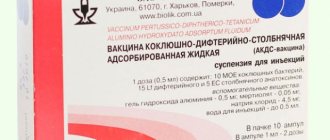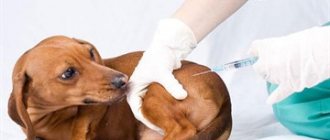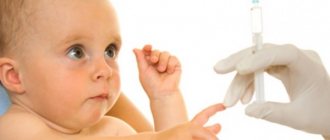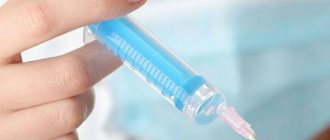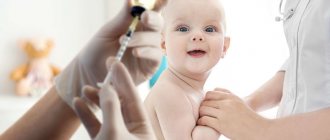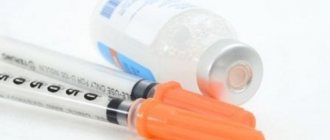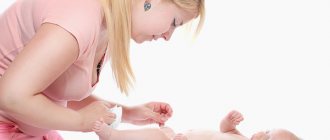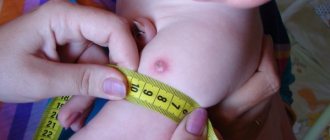Whooping cough is a disease that is dangerous for young children from birth to six months. The disease can cause various serious complications: pneumonia, acute encephalitis, weight loss, or cause death.
If children under one year of age have the disease, they require urgent hospitalization and, in some cases, intensive care units. Vaccination against whooping cough is the best way to prevent its development.
At what age are children and adults vaccinated against whooping cough?
Vaccination against whooping cough is a planned procedure, which is performed in the first six months of life, followed by revaccination.
The vaccination schedule is as follows:
- The first vaccination is given at three months of age along with the diphtheria and tetanus vaccine. After this, immunity to the disease is not developed immediately, but after all subsequent procedures.
- The second and third vaccinations are carried out at the ages of 4 and 6 months.
After time, at the age of 18 months, revaccination is carried out, which contributes to a more stable and long-term strengthening of immunity against the disease.
Vaccination during pregnancy is carried out at 27-36 weeks, which allows you to develop immunity to the disease and pass it on to the unborn child through the placenta. Vaccination of the mother is a necessary condition, since the disease is transmitted from mother to baby in more than 50% of cases.
Vaccination for pregnant women is prescribed in the form of a combined serum, which contains a vaccine against tetanus and diphtheria. It's called Tdap.
When to vaccinate?
From 3 months. Vaccination is carried out three times with an interval of 45 days and a single revaccination 12 months after the 3rd vaccination, i.e. at 18 months of age.
The optimal strategy for controlling pertussis infection is the maximum timely coverage of preventive vaccinations for children in the first two years of life within the time frame recommended by the national calendar of preventive vaccinations (at 3-4.5-6-18 months); catch-up immunization of children not vaccinated in a timely manner; carrying out age-related revaccinations against whooping cough in children aged 6-7 years, 14 years old, adolescents and adults from 18 years old every 10 years from the date of the last revaccination.
How is a prophylactic drug administered?
All drugs administered to prevent the development of diphtheria, whooping cough and tetanus are a liquid that is shaken well before administration to the patient to obtain a homogeneous mixture.
If non-dispersing flakes or lumps are found in the drug, this drug is contraindicated to be administered.
In addition to the active ingredients included in the vaccine, it contains an adsorbent and a stabilizer. The first is aluminum hydroxide, which enhances the immunogenicity of the vaccine and prolongs protection against diseases.
The stabilizer is thiomersal, which is a mercury salt in an amount of up to 25 mcg. This dosage does not pose a danger to humans.
The DTP vaccine, consisting of Tetracok and Infanrix, is administered intramuscularly to children under 18 months of age in the anterior outer surface of the thigh, and to older children - into the deltoid muscle. Previously, the injection was carried out in the gluteal muscle, but at present this technique is not recommended, since due to the presence of large adipose tissue in this area in an infant, the drug can get into the fatty tissue.
The process of administering toxoids ADS, AD-M and ADS-M to preschool children is carried out in the same way as DTP vaccines. For school-age children, the injection site may be the subscapular region, subcutaneously, but for this purpose special needles with a sharper bevel will be used .
Compared to muscle, the process of vaccine absorption from adipose tissue is much slower, which can cause the appearance of local vaccine reactions.
Contraindications for vaccination
Contraindications for pertussis vaccination as part of DPT include:
- any previous anaphylactic reactions to vaccine components;
- encephalopathy within a week after the previous vaccination with a pertussis component, unless another cause has been established;
- progressive neurological diseases.
Periods of exacerbation of infectious and non-infectious diseases, as well as exacerbation of chronic diseases are considered temporary contraindications - vaccination is carried out 3-4 weeks after recovery or during remission). For mild ARVI and intestinal diseases, vaccination is carried out immediately after the condition has returned to normal.
Since in Russia the first vaccination against whooping cough is given to newborns at 3 months, before this period the baby is unprotected from whooping cough. A baby under 8 weeks of age does not yet know how to cough, which can lead to a delay in breathing and the death of the child if he develops whooping cough. Logically, this situation can be corrected by vaccinating pregnant women against whooping cough at a later stage. In this case, the antibodies produced by the mother's body will protect the child until he reaches the age of three months.
Vaccinating the mother during pregnancy also protects her by preventing potential transmission of the disease from mother to fetus. This prevents the common route of transmission of the disease to a child from family members. More than half of children become infected with whooping cough from their parents. The acellular whooping cough vaccine is absolutely safe for the baby and mother and causes only local local reactions.
In European countries, pertussis vaccination of pregnant women is carried out in most countries. In England, for example, since 2012, in California - since 2010. The effectiveness of vaccination of pregnant women in preventing the disease in newborns is 89%. Before introducing vaccination with the Tdap vaccine (with a pertussis component) during pregnancy, studies were conducted. As a result, it was revealed that fetal immaturity was diagnosed in 8.4% of women, and premature births occurred in 6.3% of cases, which is quite comparable with the data of unvaccinated pregnant women, in whom fetal immaturity was diagnosed in 8.3%, and premature births occurred. childbirth - in 7.8%.
In Russia, vaccination of pregnant women against whooping cough has not yet been introduced into the vaccination calendar due to the lack of vaccine, but it is recommended for pregnant women in areas that are epidemically disadvantaged by whooping cough.
What is the name of the pertussis vaccine?
There are two types of whooping cough vaccine used in medicine:
- Whole cell. The drug is produced using living weakened cells.
- Split. It does not contain whole cells against the disease.
The split vaccine is less reactogenic and is much better tolerated, however, its cost is much more expensive than the whole cell vaccine.
The most common drug against infection is the complex DTP vaccine. One milliliter of the product contains 20 billion pertussis microbial cells, which equates to two dosages.
Similar means are live vaccines:
- Bubo-kok. This product additionally has protection against the hepatitis B virus.
- Tritanrix. This drug consists of protective cells against the following diseases: tetanus, diphtheria, Haemophilus influenzae, whooping cough, hepatitis B.
Gamma globulin for whooping cough
Gamma globulin is recommended for use in young children during the initial course of the disease.
Administration is indicated in the following cases:
- Children under 1 year of age.
- Unvaccinated children over 1 year of age.
- For those who have not completed their vaccination.
- Weakened by infectious or chronic diseases.
The dosage of gamma globulin is six milliliters, which must be administered three milliliters twice with an interval of one day.
If the disease was detected late, then gamma globulin can also be used to alleviate the symptoms and course of the disease.
Risk factors
Risk factors for whooping cough are conditions that are not the direct cause of the disease but are associated in some way. Having a risk factor for whooping cough increases the chances of infection, but does not necessarily lead to illness. Additionally, the absence of any risk factors or the presence of a protective cause will not necessarily prevent you from getting the disease.
The most vulnerable to this disease are:
- infants up to one year;
- children who are not vaccinated or children who are not yet fully immunized;
- those whose immunizations are “wearing out”;
- those suffering from an underlying viral cold, cough or asthma.
Adverse reactions
Vaccination against whooping cough does not end without consequences; quite often it carries with it complications. Various adverse reactions may occur:
- Aseptic infiltrate deep in soft tissues.
- Various allergic reactions, such as: rash at the vaccination site, anaphylactic shock, Quincke's edema. The last two develop in severe cases.
- Various complications occurring from the nervous system. Usually in young children they manifest themselves in the form of crying, restlessness, screaming and a short rise in temperature.
- Convulsive syndrome (encephalic reaction). This manifestation develops after two days from the date of vaccination. Convulsions begin to appear after an elevated body temperature. In some cases, loss of consciousness is possible, and with a milder course of this side effect, minor twitching of the limbs or muscles is observed.
- Encephalitis. Brain inflammation is a rare complication.
- With a sharp decrease in immunity or a poor-quality vaccine, the complication of post-vaccination whooping cough may develop.
To minimize or prevent various complications, consultation with a doctor is necessary.
Complications
The most common complication and the cause of most deaths associated with whooping cough is secondary bacterial pneumonia.
Secondary bacterial pneumonia is an illness that follows another lung infection, whether viral or bacterial. Secondary pneumonia will be caused by a different virus or bacteria than the original infection.
For infants, whooping cough is most dangerous, as are the complications associated with it, including secondary pneumonia.
Other possible complications of whooping cough, especially in babies under 6 months of age, include:
- encephalopathy (abnormal brain function due to decreased oxygen delivery to the brain caused by episodes of coughing);
- reactive respiratory diseases (asthma);
- dehydration;
- hearing loss;
- lack of nutrients.
Treatment of whooping cough in children
Often, the development of whooping cough in a child does not require hospitalization; this is done only in extremely severe cases, and in other cases, therapy is carried out at home. Doctors give the following treatment recommendations:
- Elimination of physical and emotional stress.
- Long walks in the fresh air at a temperature of at least -10 degrees Celsius.
- Fortified fractional meals.
- Taking bronchodilator or mucolytic medications to relieve cough.
- Isolation from school or kindergarten for at least a month.
- In case of oxygen starvation of tissues, nootropic drugs, oxygen therapy and glucocorticoids are prescribed.
- Taking antibiotics in the first seven days of infection.
Whooping cough is a rather dangerous disease, which is especially difficult for children under five years of age.
For this reason, doctors recommend vaccination in advance to prevent its development. Vaccination does not provide a 100% guarantee that the disease will not affect the child, however, it significantly reduces this risk.
